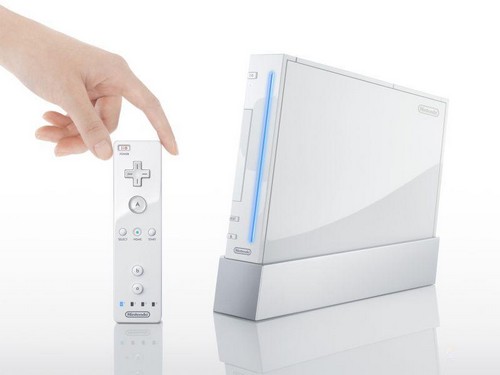consoles nitendo
Super Mario NES Games
To some people the NES was one of the greatest inventions of the 20th century! To others, Mario is the greatest thing since sliced bread. So what happens when you combine the two? Super Mario Nes games! Mario Mayhem has put together a little bit of information about each of the NES games that our Hero Mario stars in.
NES console
Nintendo Entertainment System (often referred to as NES or simply Nintendo), is an 8-bit video game console released by Nintendo in North America , Brazil , Europe , Asia , and Australia in 1985. Its Japanese equivalent is known as the ' Nintendo Family Computer or Famicom.
The most successful gaming console of its time in Asia and North America (Nintendo claims to have sold over 60 million NES units worldwide), it helped revitalize the video game industry following the video game crash of 1983 , and set the standard for subsequent consoles in everything from game design (the breakthrough platform game , Super Mario Bros. , was the system's first " killer app ") to business practices. The NES was the first console for which the manufacturer openly courted third-party developers .
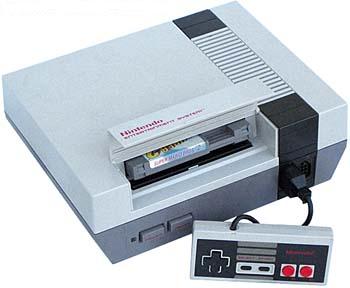
Snes console!
The Super Nintendo Entertainment System , also known as Super Nintendo , Super NES or SNES , is a 16-bit video game console released by Nintendo in North America , Brazil , Europe , and Australia . In Japan it is known as the Super Famicom (Super Family Computer). In South Korea , it is known as the Super Comboy and was distributed by Hyundai Electronics.
The Super Nintendo Entertainment System was Nintendo's second home console, following the Nintendo Entertainment System (often abbreviated to NES , released as the Famicom in Japan). Whereas the earlier system had struggled in the PAL region and large parts of Asia, the SNES proved to be a global success, albeit one that could not match its predecessor's popularity in Southeast Asia and North America—due in part to increased competition from Sega 's Mega Drive console (released in North America as the Genesis). Despite its relatively late start, the Super Nintendo Entertainment System became the best selling console of the 16-bit era.
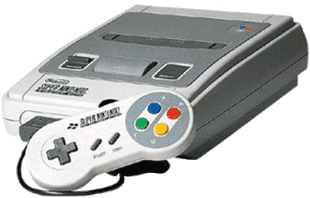
Game Boy console!
The Game Boy is a handheld game console developed and manufactured by Nintendo , released in 1989 at $89.95 USD. The Game Boy was the first successful handheld console, and was the predecessor of all other iterations of the Game Boy line .
The Game Boy was originally bundled with the puzzle game Tetris , since Nintendo thought that an addictive puzzle game would get consumers' attention.
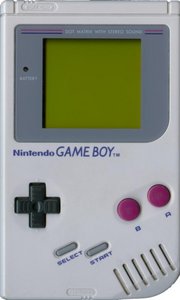
Several accessories compatible with the Game Boy were also produced:
-
The Game Boy Battery Pack (or AC Adapter ), sold for about $30 USD , was roughly 3 in. long, 2 in. wide, and 0.5 in. thick. One end of it had a 2 inch-long cord, ending in a 3.5 mm phone plug , while the other end had a standard two-pin plug . The first version of it was gray with purple lettering, to match the colors used on the Game Boy. It also featured a belt clip. The battery pack was good for several hours of gameplay per charge, providing an alternative to purchasing more AA batteries once their power was exhausted. The product used nickel-cadmium batteries , lasted about 4-5 hours per charge, and could be charged roughly 1000 times before a significant loss in effectiveness. A major drawback of the battery pack was its weight, as well as the way the phone plug sticks out prominently.
-
Game Boy Camera (Japan: Pocket Camera)Released in 1998, the Game Boy Camera was able to take pictures that could be printed out using the Game Boy Printer. The photos were in black and white only, and the resolution of the pictures was 128 x 123. Both the Game Boy Camera and Game Boy Printer products were marketed together in Japan , the U.S. , and Europe , primarily towards children. It is no longer in production by Nintendo .
-
Game Boy Printer Released at the same time as the Game Boy Camera, the Game Boy Printer was a thermal printer. It ran off of six AA batteries . In addition to printing out Game Boy Camera photos, it also ran in conjunction with several Game Boy games, such as Pokémon Yellow and The Legend of Zelda: Link's Awakening DX .
-
Game Boy Link CableAn accessory that established a data connection between two Game Boys using the same game or game from the same series. It is generally associated with its uses in the Pokémon series, which included versus battle and an exchanging of Pokédex data.
Nintendo 64 console!
It was released with three launch games in Japan ( Super Mario 64 , Pilotwings 64 and Saikyou Haniu Shogi ), and two in North America and PAL region (Super Mario 64 and Pilotwings 64 ). The N64's suggested retail price was US$ 199 at its launch.
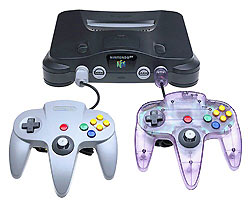
The Nintendo 64 was the last mainstream home video game console to use masked ROM cartridges to store its games (although the last real cartridge based system to have still continued production was SNK 's Neo Geo hardware until 2004 ).
Nintendo cited several advantages for making the N64 cartridge-based:
- ROM cartridges have very fast load times in comparison to disc based games, as contemporary CD-ROM drives rarely had speeds above 4x. This can be observed from the loading screens that appear in many Sony PlayStation games but are typically non-existent in N64 versions. ROM carts are so much faster than the 2x CD-ROM drives in other consoles that developers could stream data in real-time off them. This was done in Indiana Jones and the Infernal Machine , for example, to make the most of the limited RAM in N64. One could describe the ROM as an additional amount of slow RAM, similar to virtual memory in a modern operating system.
- ROM cartridges are difficult and expensive to duplicate, thus resisting piracy, albeit at the expense of lowered profit margin for Nintendo. (Nintendo had likely weighed the tradeoffs and concluded that reducing losses from piracy would offset higher cartridge production costs.) While unauthorized interface devices for the PC were later developed, these devices are rare when compared to a regular CD drive as used on the PlayStation. Compared to the N64, piracy was rampant on the PlayStation and Playstation 2.
- It is possible to add specialized support chips (such as coprocessors) to ROM cartridges, as was done on some SNES games (notably Star Fox , using the Super FX chip).
- Most cartridges store individual profiles and game progress on the cartridge itself, eliminating the need for separate and expensive memory cards . Storing data at first required a cartridge battery whose energy would diminish over time, though the battery generally lasted for years, and in subsequent games EEPROMs were used instead.
- ROM cartridges are far more durable than CD-ROMs. It is extremely difficult to damage a cartridge, whereas compact discs must be carefully used and protected in cases. This makes the cartridges better for children who do not know how to take care of CD-ROMs. It also prevents accidental scratches even by adult owners, and subsequent read errors from these inevitabilities.
- It was also a frequent occurrence for the mechanisms of early CD-ROM drives to fail. There are no moving parts with a ROM cartridge system.
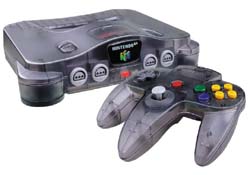
Disadvantages
- While game cartridges are more resistant than CDs or DVDs to mechanical damage, they are sometimes less resistant to long-term environmental damage, particularly oxidation or wear of their electrical contacts. (The cartridges for Nintendo's earlier NES system were particularly notorious for this)
- Console cartridges are usually larger than optical discs and hence need more storage space.
- Cartridges can store significantly less data than DVDs or CDs - some games ported from other media had to use data compression or reduced content in order to be released on the N64.
- More complex manufacturing processes meant games were usually more expensive than their Optical counterparts.
- Because of a cartridge's space limitations, full motion video was not feasible (as on CDs) for use in cutscenes.
Graphics
Graphically, results of the Nintendo cartridge system were mixed. The N64's graphics chip was capable of trilinear filtering , which allowed textures to look very smooth compared to the Sega Saturn and the Sony PlayStation; neither could provide better than nearest neighbor interpolation , resulting in textures that were highly pixelated . However, the limited storage size of ROM cartridges limited the amount of available textures, resulting in games which had blurry graphics because of the liberal use of stretched, low-resolution textures, which was compounded by the N64's 4096-byte limit on a single texture. Some games, such as Super Mario 64 , use a large amount of Gouraud shading or very simple textures to produce a cartoon-like look. This fit the themes of many games, and allowed this style of imagery a sharp look while hiding the texturing limitations of the machine.
Later cartridges such as Resident Evil 2 featured more ROM space, which demonstrated that N64 was capable of detailed in-game graphics when the media permitted.
- N64 Controller - an 'm'-shaped controller with 10 buttons (A, B, C-Up, C-Down, C-Left, C-Right, L, R, Z and Start), one analog stick in the center, a digital directional pad on the left hand side, and an extension port on the bottom. Initially available in six colors (gray, yellow, green, red, blue and black) and later in transparent version of such colors (except gray). The N64 pad's analogue stick is notorious for becoming very worn, and difficult to manipulate accurately. Also, the analog stick had to be centered properly when the system was booted up; if the stick was aimed in the wrong direction, which would be set as the default for the game, causing, for example, Mario to march off in the wrong direction without being told to do so. There are various (some quite dubious) 'DIY' ways of mending a worn-out N64 analogue stick. The problem pads are actually only from the earlier part of the N64's life-cycle, as Nintendo introduced a newer model to address the issue. While not greatly publicized, and visually identical, the redesigned pads eliminated the premature wear-and-tear problem with the analogue sticks.
- Controller Pak - a memory card that plugged into the controller and allowed the player to save game progress and configuration. The original models from Nintendo offered 256 KB Flash RAM , split into 123 pages, but third party models had much more, often in the form of compressed memory. The number of pages that a game occupied varied. A Controller Pak was initially useful or even necessary for the earlier N64 games. Over time, the Controller Pak lost ground to the convenience of a back-up battery (or flash memory) found in some cartridges. Games by Konami often required the Controller Pak for saves, even though the games could have easily contained three or more save-slots (such as in the case of Holy Magic Century )
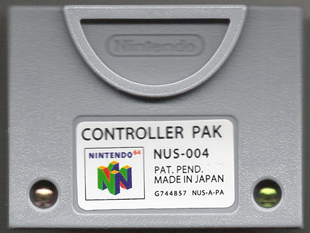
- Expansion Pak - a memory expansion that plugged into the console's memory expansion port. It contained 4 MiB of RAM . Some of the games to support this accessory are Turok 2 ,Hybrid Heaven , Pokémon Stadium 2 , Shadow Man , Star Wars: Episode I Racer , Rare's Perfect Dark , Midway's San Francisco Rush 2049 , and only a handful of games such as Donkey Kong 64 , the single-player mode of Perfect Dark and The Legend of Zelda: Majora's Mask actually required it for play. Supporting games usually offered higher video resolutions or higher textures and/or higher color depth. For example, the Nintendo 64 all-remade version of Quake 2 features higher color depth but not a higher resolution when using the Expansion Pak. The Expansion Pak was shipped with some games and also available separately.
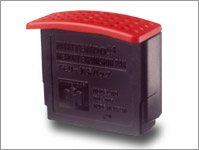
- Rumble Pak - an accessory that plugged into the controller and vibrated during game play. It has (since its release in 1997 alongside Star Fox 64 ) become a built-in standard for the current generation console controllers, with the exception of the Playstation 3, which, due to lawsuits, was left out of the controller.
- Transfer Pak - an accessory that plugged into the controller and allowed the Nintendo 64 to transfer data between Game Boy and N64 games. Pokémon Stadium and Pokémon Stadium 2are games that rely heavily on the Transfer Pak. Both versions of Mario Golf & Mario Tennisused it too. Rare's Perfect Dark was initially going to be compatible with the Transfer Pak in order to use pictures taken with the Game Boy Camera in the game but this function was scrapped, and the Transfer Pack was usable only in combination with the Game Boy Color version of Perfect Dark for unlocking bonuses.
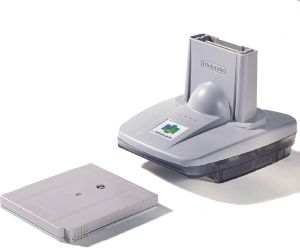
- The Wide-Boy 64 an adapter similar to the Super Game Boy and was able to play Game Boy games; however, it was only released to the developers and the press. Third party adapters allowed regular consumers to do the same.
- 64DD - The official N64 Disk Drive attachment was a commercial failure and was consequently never released outside of Japan. It featured networking capabilities similar to the SNES Satellaview.
- VRU (Voice Recognition Unit) - this device is packed in and required to play Hey You, Pikachu! . It consisted of a ballast that connects into controller port 4 of the system, a microphone , a yellow cover for the microphone and a clip for clipping the microphone to the controller. Players would hold the R or Z button on the controller and talk to Pikachu . One major drawback is the fact that the VRU is only calibrated to high pitched voices like that of a child as stated in the manual, so an older child will have problems issuing commands. However, most males can use their falsetto to talk in a higher voice.
- Dance Pad (Japan Only) - A dance pad packaged with Dance Dance Revolution: Disney Dancing Museum.
Third party accessories
- Game Shark - A cheat device made by Interact. Two versions were made. The first version had a LED display that would count down 5 seconds upon turning the system on. The period in the display would be lit while playing to show that the unit was functioning. There is a slot on the back of the unit for an expansion card that was never made. The second version (Known as the 'Pro' series, versions 3.2 and up) had a SCSI or parallel port on the back for connecting to a computer for downloads. It also featured a cheat search function as well as being able to find the name of the game for you. It also had a LCD display that counted down 5 seconds when started and the period in the display would be lit while playing to show that the unit was functioning. This feature was removed in version 3.3.
- Sharkwire Online Keyboard - An Interact device that adds a modem and PC style keyboard to the Nintendo 64 with expansion pack. Allowed emailing and Game Shark updates through the now discontinued sharkwire.com dial-in service.
- GB Hunter - Like the Super Game Boy, connects to the N64's Cartridge slot and allows you to play Game Boy and Game Boy Color games on it.
- Dex Drive - Made by Interact, allowed you to upload data from your memory cards and either store the files on your computer, or send via the internet.
- High Rez Pack - Mad Catz own version of the Expansion Pak. Performs the same job for less money, though there were reports of overheating due to inadequate cooling/venting, and generally inferior quality.
- Bio Sensor - An ear-clip that plugs into the Controller Pak slot of the N64 controller to measure the user's heart rate . Released only in Japan and compatible only with Tetris 64where it will slow down or speed up the game depending on how fast the player's heart is beating.
- Battery free Rumble Paks (3rd party) - late in the N64's run, a few 3rd party companies made rumble paks that worked without batteries but instead drew their power from the system.
Nintendo DS console!
Released: November 21, 2004
The Nintendo DS , sometimes abbreviated NDS orDS , is a handheld game console developed and manufactured by Nintendo , and first released in 2004 . The console features a clamshell design, with two LCD screens inside - one of which is a touch-sensitive screen .
The DS can stand for "Dual Screen," andDevelopers' System, from Nintendo's belief that the system "gives game creators brand new tools which will lead to more innovative games for the world's players."
On March 2 , 2006 , Nintendo released the Nintendo DS Lite in Japan , a redesigned system which is slimmer and lighter with brighter screens, a longer and thicker stylus for the touch screen, and a relocated microphone. It was released later the same year in North America , Europe , Australia , and China.
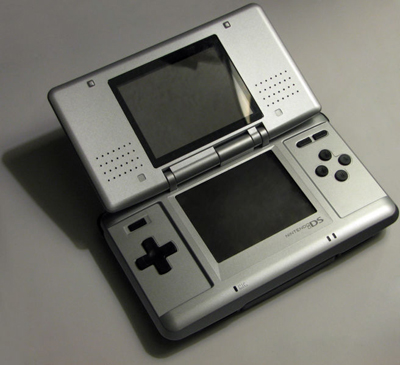
Accessories
Although the secondary port on the Nintendo DS does accept and support Game Boy Advance cartridges (but not Game Boy, and Game Boy Color cartridges), Nintendo has emphasized that its main intention for its inclusion was to allow a wide variety of accessories to be released for the system, the Game Boy Advance compatibility titles being a logical extension.
Nintendo announced at E³ 2005 that it would launch "Headset Accessories" for VoIP enabled games. (This will plug into the VoIP plug next to the Ear Phone jack, not the Game Boy Advance slot.)
Rumble Pak
The Rumble Pak was the first official expansion slot accessory. In the form of a Game Boy Advance cartridge, the Rumble Pak vibrates to reflect the action in compatible games, such as when the player bumps into an obstacle or loses a life. It was released in North America and Japan in 2005, as a separate accessory and bundled with Metroid Prime Pinball A specially designed Rumble Pak was released in Japan in late May 2006 for the Nintendo DS Lite The cartridge is about 1 cm shorter to prevent it from protruding out of the Nintendo DS Lite as standard Game Boy Advance cartridges do.
Nintendo DS Headset
The Nintendo DS Headset is the official headset for the Nintendo DS. It plugs into the headset port (which is a combination of a standard 3.5mm headphone connector and a proprietary microphone connector) on the bottom of the system. It features one earphone and a microphone, and is compatible with all games that use the internal microphone. It was released in Japan on September 14 , 2006.
Opera internet browser
On February 15 , 2006 , Nintendo announced a version of the cross-platform web browser Opera for the DS system. The browser can use one screen as an overview, a zoomed portion of which appears on the other screen, or both screens together to present a single tall view of the page. The browser went on sale in Japan and Europe in 2006. Releases in other regions are expected in 2007.
Nintendo Wi-Fi USB Connector
This USB-flash-disk-sized accessory plugs into a PC's USB port and creates a miniature hotspot, allowing up to five Nintendo DS units to connect to the Nintendo Wi-Fi Connection service through the host computer internet connection. Currently this device is only compatible with Windows XP.
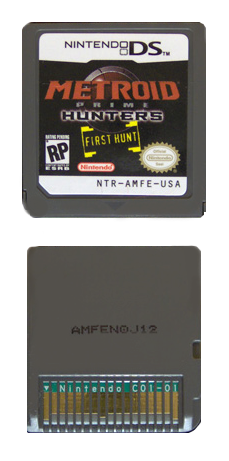
Nintendo MP3 Player
On November 22 , 2006 , Nintendo confirmed an MP3 player accessory for the DS will launch in Europe on December 8 , 2006 . No price has been released by Nintendo, but many sources suggest a €30 price tag. The add-on will use SD cards and will use an odd 8-bit style GUI. The cause for such a low bit GUI is that to run MP3s the DS is forced to use the ARM9 processor, which is also used for running the GUI and most of the game code. Running MP3s on the ARM9 will use about 95% of it. Other non-Nintendo brand compact flash (CF) memory card readers which claim to turn the DS into a "multimedia powerhouse" have been released and are avaible at retail stores such as Walmart. The CF readers can view MPEG4 videos and play WMA and MP3 music files. They retail for $40.
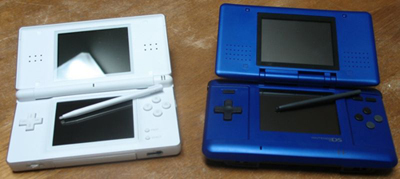
Game Cube console!
The Nintendo GameCube is Nintendo's fourth home video game console, belonging to the sixth generation era. The GameCube itself is the most compact and least expensive of the sixth generation era consoles. The GameCube was released on September 14 , 2001 in Japan ; November 18 , 2001 in North America ; May 3 , 2002 in Europe ; and May 17 , 2002 in Australia .

The GameCube was unveiled on 24 August 2000 , one day before Nintendo's SpaceWorld trade show. Shaped roughly like a cube , the console is available in a variety of colors, such as indigo, platinum, and black (also a limited edition Resident Evil 4 platinum and black game console). In Japan, the system is also available in Spice (orange), or in limited edition colors like Crystal White, Mint Green, Copper, and White with black pinstripes.
The Nintendo GameCube uses a proprietary storage medium, the Nintendo GameCube Game Disc , based on Matsushita 's optical-disc technology; the discs are approximately 8 centimeters (3 1/8 inches) in diameter (considerably smaller than the 12 cm CDs or DVDs used in competitors' consoles), and have a capacity of approximately 1.5 gigabytes . Contrary to popular belief, GameCube discs are not physically read any differently from a standard DVD disc, but are encrypted with a key derived from the Burst Cutting Area, a 'bar code' unreadable by most DVD drives. This move was intended to prevent unauthorized copying of GCN titles, but was eventually cracked . By exploiting a flaw in Phantasy Star Online Episode I & II , users were able to connect their GameCubes to their PCs and run homebrew programming on the console.
The Nintendo GameCube does not have DVD or audio CD support, but Matsushita 's Panasonic Q (described below), only available in Japan, does. Common reasons cited by Nintendo for using this format are to reduce copyright infringement, provide faster loading times, make the system cheaper by avoiding DVD-licensing fees, and allow smaller discs. The lack of DVD movie support was a double-edged sword; it did not appeal to the mass audience that turned to the PlayStation 2 and Xbox due to their built-in DVD support. A number of games with large amounts of audio or video were scaled down when ported to the GameCube. [ citation needed ] Despite the protection of a non-standard disc format (essentially a miniature DVD-ROM with non-standard sectors and filesystem formatting), a number of modchips such as the Qoob and ViperGC have been released that, when used in conjunction with a modified BIOS , allow the use of a standard or 8 cm DVD-R to load backed-up , homebrew , bootleg or copied software . The Panasonic Q , released by Panasonic in Japan under license from Nintendo, is manufactured as a modified GameCube unit with added DVD and audio CD playback functionality. It was never released outside of Japan; production ceased in December 2003. Differences in design make the Panasonic Q incompatible with the Game Boy Player . However, the Panasonic Q Game Boy Player was released to address the problem of the extended pegs on the bottom, allowing play of Game Boy games.
The GameCube can connect to a Game Boy Advance or Game Boy Advance SP to transfer game data. The GameCube can also connect to a Game Boy Micro , but the cable required to connect the two must be custom made since it has not been otherwise made available. Examples of this functionality include the use of the Game Boy Advance as a controller for the game played. Information related to game play may be displayed on the Game Boy Advance's color screen for added convenience or to avoid the cluttering of the display on the television screen. This functionality has been used to unlock bonuses such as new levels or characters when certain Game Boy Advance and GameCube games are connected together. Up to four Game Boy Advance systems can be connected to the GameCube through the GameCube's four controller ports for multiplayer play. A Nintendo GameCube-Game Boy Advance cable is required for each system that is connected to the GameCube. However, this required a user to buy a GameCube, a Game Boy Advance, and the GameCube version of the title, along with the Game Boy Advance version. Some GameCube titles only used the Game Boy Advance as a screen and did not require a separate Game Boy Advance game.
The GameCube can also connect directly to another GameCube for LAN play. Another television is needed for the second console. The Gamecube can connect over LAN with up to eight other GameCubes.
The GameCube was designed for portability, with its small size complemented by a carrying handle. However, this feature over other consoles was minimal since its inexpensive production and selling price were its main advantages. Despite being more compact than the original PlayStation 2 model (it was released over a year later and kept the power supply separate from the console), the GameCube has overall superior graphics processing power and better Pro Logic sound , but no optical output. The GameCube has a front end menu system which can be accessed by holding the 'A' button while the system boots or by booting with no game inserted. This menu controls settings for memory card data, sound, and the internal clock.
The controller has the traditional directional pad, two analog sticks, and eight buttons: A, B, X, Y, Z, L, R, and pause/start. Like the Nintendo 64 controller , it features no select button. The C buttons have been replaced by an analog C stick. The analog sticks do not have added "clickable" button functionality—unlike other such consoles of the era—but both L and R shoulder buttons are analog, able to detect pressure applied to them before "clicking," essentially doubling their functionality.
Nintendo released a network adapter for the GameCube during the Christmas season of 2002, but did not promote or support online gaming as heavily as Sony or Microsoft. Two adaptors were released: the Nintendo GameCube Modem Adapter for dial-up and the Nintendo GameCube Broadband Adapter for broadband. The only high-profile title that requires the adapter is Sega'sPhantasy Star Online Episode I & II . Instead, Nintendo focused more on Game Boy Advance connectivity.
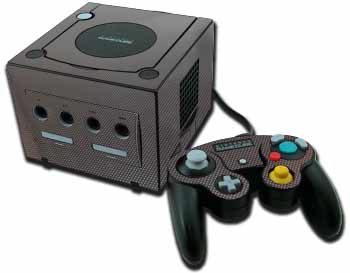
First-Party and Officially Licensed Accessories/peripherals
- Controller (Standard colors include Indigo, Black, Spice (Orange), Platinum and Indigo-clear). There are also many limited edition controllers available such as a split blue and red, with the Mario "M" logo replacing the regular GameCube logo seen on standard controllers (there have also been green and blue Luigi "L" controllers and similarly yellow and pale blue Wario "W" controller). There are also specially shaped controllers.
- WaveBird ( RF wireless controller)
- Memory Card 59 (4Mb), 251 (16Mb) or 1019 (64Mb) blocks, with a maximum of 127 files can be stored on a single card
- Nintendo GameCube-Game Boy Advance cable (for games that support connectivity between the GameCube and the Game Boy Advance)
- Modem or Broadband adapter (for internet or LAN play) both of which connect to the Serial Port 1
- Game Boy Player (to play Game Boy games on the television, using either a GameCube controller or a connected Game Boy Advance) which connects to the Hi Speed Port
- Component video cable (for progressive scan ( 480p ) support) which requires a GameCube with Digital Video Output. Less than one percent of GameCube owners used 480p; therefore the digital output was eventually removed from the design to reduce the system's manufacturing costs. (See System Specifications above and Official Information .)
- D-Terminal Video Cable - allows Progressive Scan mode to be enabled through a D-Terminal port on a TV. It was sold in Japan only. An analog A/V cable is still required for audio.
- RGB Cable - provides a better quality picture than composite cables. It utilizes the SCART connector standard and is sold in Europe only.
- S-Video Cable - provides a better quality picture than composite cables, although not up to that of the RGB Cable . Only NTSC Gamecubes could use the S-Video cable.
- VGA Adapter - allows GameCube play on a standard computer monitor. A game supporting 480p combined with the Component Video cable above, and the VD-Z3 (which has a monitor pass-through) can give progressive scan display quality on a computer monitor.
- In PAL regions, an RF cable for connection to older televisions.
- RF Switch in NTSC regions for connection to older televisions. Essentially a NES RF box with a matching unit attached to fit the multi-out of the Game Cube.
- DK Bongos for use with the music games Donkey Konga , Donkey Konga 2 and Donkey Konga 3, the Donkey Kong platform title Donkey Kong Jungle Beat , and the soon-to-be released racing game DK Bongo Blast .
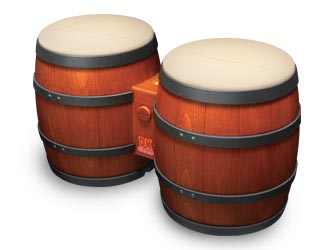
- Microphone , which plugs into memory card slot, for use with Mario Party 6 , Mario Party 7 , and Karaoke Revolution Party . Odama also includes a microphone clip to clip on to the controller. Commands are issued when you hold the X button on the controller.
- SD Card Adapter, for games exhibiting the SD Card logo like Animal Forest e+ . This official Nintendo accessory is currently sold in Japan only.
- A dance pad , included with Dance Dance Revolution: Mario Mix . It has 4 arrows.
- A Beat Pad made by Mad Catz and officially licensed by Nintendo, included with the game MC Groovz Dance Craze . Also sold separately. It has 8 arrows.
- An ASCII keyboard controller, resembling a standard GameCube controller pad stretched to accommodate an alphanumeric keyboard in the center. The keyboard requires the use of two controller ports, and contains both Roman and Japanese hiragana characters. It is considered particularly useful for Phantasy Star Online Episode I & II and is difficult, though not impossible, to acquire outside of Japan. A cheaper and easier keyboard to import is made by Datel , although most people opt to purchase just an adapter so they can use their own PC keyboards.
- Hori Game Boy Player Controller - A controller designed to play with the Game Boy Player. It only came in the colors Indigo and Jet Black. The controller is in the shape of a Super Nintendo control pad. It does not include the Control Stick or C-Stick, and the R and L buttons lack a range of pressure sensitivity; thus, only uses the D-Pad for movement and the usual buttons for playing. They were released only in Japan, and are officially licensed Nintendo products. Although meant for the Game Boy Player , this pad can still be used with certain 2-D GameCube games, such as Alien Hominid or the Mega Man collections.
- Logitech Speed Force Racing Wheel - An officially licensed force feedback steering wheel made exclusively for the GameCube. It is supported by a number of games, including F-Zero GX, R: Racing Evolution, Mario Kart: Double Dash!, Burnout 2, and the Need for Speed series, among others. There is also an optional accessory pack which includes foot pedals and a lap attachment.
- ProDG , an officially licensed development tool for the GameCube. In a photo from the product's home page at [8] , the cable appears to be protruding from the left side of the case where the Serial Port 2 should be. If this does connect to that port, this would be the only accessory known to do this.
Wii console!
A distinguishing feature of the console is its wireless controller , the Wii Remote , which can be used as a handheld pointing device and can detect motion and rotation in three dimensions . Notable among the console's internal features is WiiConnect24 , which enables it to receive messages and updates over the Internet while consuming very little electrical power.
Nintendo first mentioned the console in the 2004 E3 press conference and later unveiled the system at the 2005 E3. Satoru Iwata revealed a prototype of the controller at the September 2005 Tokyo Game Show . In the 2006 E3, it won the first of several awards.
